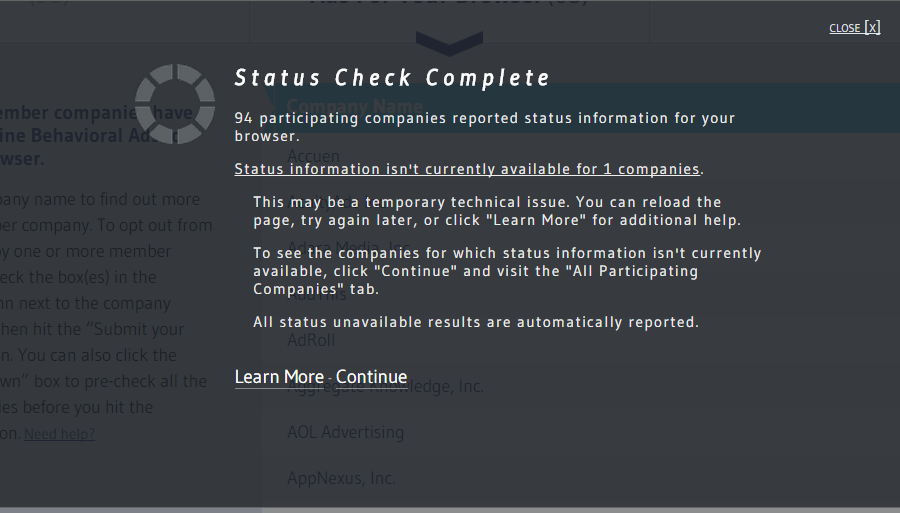This post is intended to give you some background information about advertisement brokers, the men and women that are in the middle of web advertising.
In a market consisting of media providers (in this case mostly websites) on one side and advertisers on the other, the advertising brokers strive to optimize the effect and the revenue of advertisements.
Some of the domains that are in use by these advertisement brokers may be blocked by the Web protection that is part of Malwarebytes Anti-Malware Premium. But this is only done when and if we are aware of problems that may pose a threat to our customers.

How these problems can arise
The website owner will want to maximize the sites revenue, but at the same time wants the advertisements to be as unobtrusive as possible.
And the advertiser will want to reach that part of the public that can be expected to be interested in what he’s selling.
For example, advertising for diapers on a site about pensions would be considered a waste of money, because the advertisement would hardly reach those that are interested in diapers.
Advertising for toys on a children’s movie channel however would be very effective since it peaks the interest of the children and they will ask their parents for them.

The process of getting the right match between advertisements and websites is called advertisement brokerage. In many cases this process is fully automated.
Advertisements can be aimed at the public you may expect on a certain site (content relevant). Or they can be aimed at the visitor personally (interest based), provided they can gather enough information about said visitor by reading his cookies or by recognizing a personally identifiable feature.
In the latter cases the advertisements you will see on a certain site may be completely different from the ones that I’m seeing. The advertisements are fetched as a “last split-second” decision based on the interests the visitor is known or expected to have.
This procedure is known as Real-Time Bidding (RTB) and there is a very informative post on our blog about how that can be abused by malvertisers. The short version is that ad networks can be compromised or abused to present malvertisements.
And malvertisements are exploits that don’t require any user input to trigger an infection process. So you don’t have to click on anything to get infected.
Don’t confuse this with being infected with adware
For users that are looking at interest based advertisements all the time, this can lead them to think their computer has been affected by adware.
Which makes sense if you realize how much the advertisers already know about them and how the same ads will show up at different sites.
For example, every time I visit Facebook nowadays, I am looking at an advertisement from a garage that keeps telling me my car is almost up for its yearly inspection. Which is true, but how do they know?
I think it is because I have used that garage in the past and made reservations through their website. So, they must have used my Facebook cookie and connected the dots. I’m sure you have seen examples of this behavior as well if you’re not using an ad-blocking type of software.
If you do a search for some item, there is a good chance you will see advertisements for that same item appearing left and right while you browse the internet. Don’t get me wrong, I’m not complaining. Sometimes this can even be helpful, but it’s spooky if you are unaware of the mechanisms behind interest based advertising.

My point is: be wary of a big influx of advertisements, but don’t jump to the conclusion your computer is infected with something or other. Of course it never hurts to scan your computer with Malwarebytes Anti-Malware just to make sure, but don’t rule out the power of interest-based advertising.
Ad networks
For your convenience I have tried to make a list of the most prevalent ad-networks that don’t use adware, but use interest based advertising on websites:
- AdCash
- AdSense/AdChoices
- Adsrvmedia
- AOL Advertising
- Chitika
- Dedicated Media
- Media Nexus
- MoPub
- SmartyAds
- Traffiliate
This list is far from complete. A more extensive list that also provides you with an option to opt out of some of the interest based advertising can be found at the site of the Network Advertising Initiative (NAI).
It may also be worth your while to visit the site of the Digital Advertising Alliance responsible for your region. On both sites you can find a list of participating companies and do a status check with your favorite browser to see which ones are available for you to opt out of.

Social Media
Social media are a big source of information for interest based advertising. So I have gathered some links where you can limit the digital trail you are leaving behind.
To learn how you can change your Facebook ad preference settings you can look at this page in the Help Center.
The same page can be used for Instagram which respects your Facebook settings.
For Twitter you can learn how to manage your privacy settings on this page about Twitter Ads.
On LinkedIn you have to scroll down under Profile and click on the Ad Choices link to find the option to opt out.
If you know of any more feel free to post them in the comments.
Pieter Arntz










